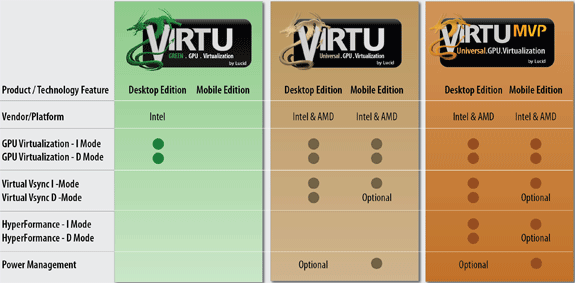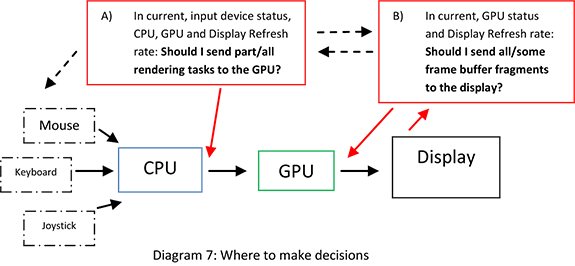IDF 2011: Lucid Announces Virtu Universal MVP Featuring HyperFormance Technology (Update)
by Ryan Smith on September 14, 2011 3:16 AM EST- Posted in
- GPUs
- Lucid
- IDF 2011
- Trade Shows
At the start of 2011 Lucid announced their Virtu software to go with Intel’s Sandy Bridge CPUs. With Virtu users would be able to use a discrete GPU and Sandy Bridge’s integrated GPU simultaneously in order to use the features of both GPUs. This normally meant either using a dGPU as the primary GPU while still being able to access Sandy Bridge’s QuickSync (D-mode), or using the iGPU as the primary GPU while having the dGPU power up and render frames to the iGPU when the dGPU’s capabilities were needed (I-Mode).
More recently in June at Computex they announced Virtu Universal. Virtual Universal added support for using Virtu with AMD’s integrated GPUs, and introduced the company’s Virtual Vsync technology for preventing screen tearing without using vsync.
Lucid has continued to work on Virtu since then, and finally at today’s IDF they’re announcing their latest rendition of Virtu: Virtu Universal MVP. Virtu Universal MVP adds Lucid’s latest technology, which the company is calling HyperFormance technology. Lucid is claiming that with HyperFormance they will be able to significantly improve I-mode rendering performance by “removing redundant rendering tasks”, or in essence they will be improving performance by rendering less.

So what exactly is HyperFormance? That’s a great question, and we don’t have a great answer. Lucid has decided to keep the mechanisms of HyperFormance under wraps for patent purposes, so what we have to work with amounts to a very high level overview. In this overview Lucid has made it clear here that the principle feature of HyperFormance is that it’s reducing the rendering workload on the dGPU by intercepting and removing some rendering tasks within a frame. This in turn would reduce input lag by either allowing a GPU to render a frame faster and move on to the next frame, or just hold off entirely until it's closer to a refresh cycle so that the rendered frame is not as old.
The long and short of it is that Lucid seems to have integrated the basis of Hydra – their largely ignored multi-GPU rendering technology – into Virtu, and are using Hydra’s ability to split up drawing commands to remove drawing commands heading to the GPU entirely. The unknown part of the equation is how Lucid is deciding what to remove. Based on what we’ve seen of Hydra it seems unlikely that this is a hidden surface removal technology, in which case it’s more likely that it’s an attempt to calculate and only render parts of an image that have changed from a previous frame – a GPU form of delta/inter-frame compression.

What’s also clear is that HyperFormance goes hand-in-hand with Lucid’s Virtual Vsync technology, which appears to do something like that (as with HyperFormance, they aren’t saying how Virtual Vsync works either). The significance here is that while HyperFormance would be looking at a frame based on draw commands, Virtual Vsync works off of a finished frame. So HyperFormance is getting some kind of feedback for future frames based on Virtual Vsync’s analysis of the completed frames.
Beyond this we know very little about the technology, or more importantly what the pitfalls may be. The immediate concern is that not rendering something could very result in the final composited image being wrong in some manner, or that doing all of this analysis may increase input lag more than a faster framerate decreases it. More interestingly though, because they need to analyze both draw commands and the rendered frame, HyperFormance only works in setups with multiple GPUs (i.e. iGPU + dGPU), as Lucid needs to be able to completely control the input and the output of the dGPU. So I-mode could potentially have less input lag than using just a discrete GPU with V-sync, and Lucid is promising just that. It certainly seems farfetched, but not impossible with the little information we have to work with.
In any case as Lucid has just announced Virtu Universal MVP, HyperFormance is not yet available for testing. Once Lucid makes it available for review it’s definitely something that bears following up on, so stay tuned.
Update: We had a chance to talk to Lucid about HyperFormance and Virtual Vsync in more detail, and have updated our article accordingly. One thing Lucid has made very clear is that while HyperFormance technically improves framerates, this is not the intention of the technology. Indeed it's largely a side effect of the fact that with HyperFormance the GPU is rendering some (or none) of a frame while still reporting to the CPU that the frame has been rendered and the buffers flipped.
The principle purpose of HyperFormance is to reduce input lag, and this is a logical extension of Virtual Vsync - if something is not going to be displayed (e.g. it will be an out of date frame by the time the next buffer flip comes around), why render it? Ultimately what Lucid is doing here is a creative workaround on updating the display without always waiting up to 16ms for a new refresh cycle with v-sync, and an even more creative workaround for the fact that modern GPUs typically have up to several frames in their rendering pipeline. The end goal is to display as new a frame as possible, as waiting for refreshes and having multiple frames in the rendering pipeline both contribute to input lag.
Of course it goes without saying that there are good reasons that modern GPUs have a frame pipeline, and this is primarily to smooth out the framerate so that it doesn't constantly fluctuate (creating a microstutter-like effect) and so that the CPU doesn't end up waiting on the GPU. Lucid contends that their solution can handle these issues without buffering additional frames - and thereby without increasing input lag - and it will be interesting to put this to the test once Virtu Universal MVP finally ships.










13 Comments
View All Comments
IlllI - Thursday, September 15, 2011 - link
is it just me or is this is all starting to remind me of those 'memory optimizer' programs back in the windows 95 days.Marcio K - Friday, September 16, 2011 - link
I have a Sandy Bridge Intel board with an Core i5 2500 and a Radeon video card, upgraded just to use QuickSync to render Full HD videos, with PowerDirector 9. But Virtu (supplied with the board) never supported video applications besides Media Expresso and Media Converter.With and older version of Virtu, adding manually all the .exe files of PowerDirector made QuickSync available inside the software (albeit with somewhat erratic behavior). But this approach never worked anymore in the newer versions.
I've made the upgrade to Sandy Bridge putting my faith in Virtu to use QuickSync, and it was a BIG dissapointment.
Vinny DePaul - Friday, September 16, 2011 - link
The last Lucid product was a big disappointment. It will be good for general users if it will work as well as it says. There are times Lucid is slower than just the stand alone graphic card.